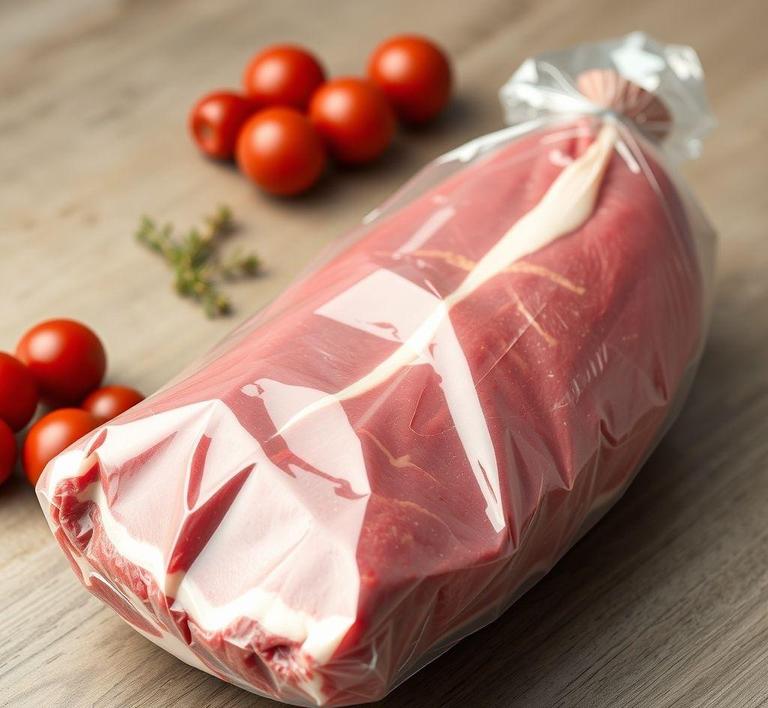Refreezing vacuum-sealed meat can be a convenient way to extend its shelf life and reduce food waste, but there are a few key things to keep in mind to ensure safety and quality. When meat is vacuum-sealed, the packaging helps preserve its freshness by reducing exposure to air, which can slow down freezer burn and bacteria growth. However, even though vacuum sealing helps maintain its texture and taste, refreezing it after it’s been thawed may impact its quality. In this guide, we’ll walk you through the best practices for safely refreezing vacuum-sealed meat, so you can make the most of your food without compromising on flavor or safety.
Can You Refreeze Vacuum Sealed Meat?

When it comes to food safety and preservation, one of the most common questions that arises is whether it’s safe to refreeze meat-especially meat that has been vacuum sealed. The short answer is yes, but with several important caveats.
Vacuum sealing meat before freezing it is a great way to extend its shelf life, as the process eliminates air that could lead to freezer burn or spoilage. This makes vacuum-sealed meat an excellent candidate for freezing in the first place. However, when it comes to refreezing, there are some crucial considerations to take into account. The primary concern lies in how the meat was handled before freezing and how many times the process of thawing and refreezing occurs.
The key to understanding whether vacuum-sealed meat can be safely refrozen lies in the thawing process. As meat thaws, bacteria present on its surface can multiply rapidly if it’s left at unsafe temperatures. The USDA recommends that meat should not be left in the "danger zone" (between 40°F and 140°F) for more than two hours, as this is when bacteria thrive. Therefore, if meat is thawed improperly or has been left out too long, refreezing it could be risky, leading to foodborne illness.
How To Refreeze Vacuum Sealed Meat?
If you’ve thawed vacuum-sealed meat and you decide you want to refreeze it, there are a few important steps to ensure that it is done safely and without compromising its quality too much. Here’s a step-by-step guide on how to refreeze vacuum-sealed meat properly:
-
Thaw Meat Safely
Always thaw meat in the refrigerator or using the cold-water method, never at room temperature. Thawing in the fridge ensures that the meat stays at a safe temperature (below 40°F), while the cold-water method involves placing the meat in a sealed bag and submerging it in cold water, changing the water every 30 minutes. The microwave method is also acceptable if the meat will be cooked immediately after thawing, but it’s not ideal for refreezing.
-
Examine the Meat
Before deciding to refreeze, take a moment to assess the meat. Does it have an off smell? Does it appear slimy or discolored? If so, it is better to discard the meat rather than risk food poisoning. If it still looks and smells fresh, then you can proceed with refreezing.
-
Limit Refreezing to One Time
The general rule of thumb is that you should only refreeze meat once. Each freeze-thaw cycle can impact the quality, texture, and flavor of the meat. When meat is frozen, the ice crystals that form can rupture the muscle fibers, leading to a loss of moisture. Every time it is frozen and thawed, this process accelerates, leading to a mushier texture and potentially dry or tough meat.
-
Vacuum Seal Again (Optional)
If you initially vacuum sealed the meat, and you’ve opened the packaging before refreezing, it’s a good idea to reseal it in a vacuum-sealed bag before putting it back in the freezer. This will prevent air from affecting the meat and reduce the risk of freezer burn, which can occur when the meat is exposed to air.
-
Label the Packaging
It’s essential to label any meat that’s been refrozen with the date it was first frozen and thawed. This helps you keep track of how long it’s been in the freezer and when it’s best to use it. Meat can last longer in the freezer, but the longer it stays there, the more it can degrade in terms of quality.
-
Refreeze Promptly
After refreezing, make sure the meat goes back into the freezer as soon as possible. Ideally, it should be placed in the coldest part of the freezer, which is typically towards the back or bottom. The quicker it freezes, the better the meat will retain its quality.
Quality Impact
While refreezing vacuum-sealed meat can be done safely, the quality of the meat can be impacted. Several factors come into play here:
-
Texture Changes
Each freeze-thaw cycle causes the formation of ice crystals that can rupture the fibers of the meat. This leads to a breakdown of the structure, resulting in a slightly altered texture. Meat that is refrozen multiple times will likely be mushier and less firm than it was before.
-
Moisture Loss
The more times meat is frozen and thawed, the greater the loss of moisture. As water is drawn out, it takes some of the meat’s natural juices and flavor with it. Refrozen meat might taste drier or less juicy, especially if it’s not properly resealed in a vacuum bag. The reduction in moisture can also make the meat less tender.
-
Flavor Degradation
The process of freezing and refreezing may cause some degradation of the meat’s flavor. Over time, proteins and fats can break down, which might lead to a less fresh taste. The risk of freezer burn, even with vacuum sealing, increases when meat is left in the freezer for extended periods. This can lead to off flavors that are unpleasant.
-
Nutrient Loss
While freezing meat does not cause a major loss of nutrients, repeated cycles of freezing and thawing can lead to some nutrient degradation. Vitamins, especially those sensitive to temperature fluctuations like vitamin C, may decrease in potency, but protein levels are generally preserved.
-
Bacterial Growth
The most significant risk to the meat’s safety comes from improper thawing and refreezing. If meat spends too long in the danger zone during the thawing phase or if it’s refrozen multiple times, bacterial growth can occur, which may lead to foodborne illnesses.
It is possible to refreeze vacuum-sealed meat, but it should only be done with caution and after considering both safety and quality. The ideal way to handle meat is to only thaw it once and cook it before refreezing, as repeated cycles of freezing and thawing can reduce the texture, flavor, and overall quality. Always ensure that meat is thawed safely and refrozen promptly, preferably within a day of thawing, to minimize bacterial growth and prevent contamination.
Vacuum sealing adds a layer of protection for the meat by reducing exposure to air and preventing freezer burn, but it doesn’t eliminate the fact that each freeze-thaw cycle has an impact on the overall experience. By following proper thawing, refreezing, and resealing protocols, you can enjoy safely refrozen vacuum-sealed meat without compromising too much on its quality. Nonetheless, for the best possible results, it’s advised to plan your meat usage so that it does not need to be refrozen more than once.
Is It Safe To Refreeze Vacuum Sealed Meat?
Refreezing vacuum-sealed meat can be a tricky matter, as it involves careful attention to both food safety and quality. Let’s break down the factors involved.
Vacuum sealing meat is one of the best methods for preserving its freshness and extending its shelf life. When vacuum-sealed, the air is removed from the packaging, preventing the growth of aerobic bacteria and slowing down the natural deterioration process. However, once the meat has been thawed, it’s exposed to temperature fluctuations and possible bacterial growth, which can affect its safety when refrozen.
The Short Answer: Yes, it is generally safe to refreeze vacuum-sealed meat, but there are important conditions and considerations.
- Thawing Process: The method of thawing plays a crucial role. If meat is defrosted in the refrigerator at a consistent temperature (below 40°F or 4°C), the chances of bacterial growth are minimized, making it safer to refreeze. Avoid thawing meat at room temperature or using the microwave, as these methods may not defrost it evenly, increasing the risk of bacterial contamination.
- Quality Loss: While refreezing meat is safe, the quality of the meat may decline with each freeze-thaw cycle. Refreezing can result in changes in texture, juiciness, and overall flavor due to the formation of ice crystals. These crystals rupture muscle fibers and cellular walls in the meat, causing moisture loss during subsequent thawing.
- Time Constraints: The longer the meat has been thawed, the greater the risk of bacteria multiplying, which can lead to foodborne illness. It’s essential to refreeze the meat as soon as possible if you’ve thawed it, and only if it’s been safely stored in the refrigerator.
To sum up, refreezing vacuum-sealed meat can be safe if done under the right conditions: thawing in the fridge, maintaining safe storage temperatures, and ensuring that the meat is still within its quality window.
Signs That Vacuum Sealed Meat Should Not Be Refrozen
While refreezing meat can sometimes be done safely, there are several indicators that suggest the meat should not be refrozen. These signs generally point to issues related to food safety or spoilage.
- Foul Odor: The most obvious sign that meat has gone bad is a strong, unpleasant odor. Fresh meat should have a clean, slightly metallic or neutral smell, depending on the type of meat. A sour, rancid, or ammonia-like smell is a clear indicator that the meat is no longer safe to eat, and refreezing will not make it safe again.
- Slimy Texture: If the meat feels slimy or sticky to the touch, this is often a sign of bacterial growth. Refreezing meat with a slimy texture can result in further contamination. This is particularly common with chicken, pork, and fish.
- Color Changes: Vacuum-sealed meat should maintain its original color when stored properly. If the meat has turned a grayish or greenish hue, especially if it has been thawed and left for too long, it could indicate spoilage. Refreezing meat with significant color changes is not advisable.
- Excessive Ice Crystals or Freezer Burn: When vacuum-sealed meat is improperly stored or has been frozen for an extended period, the formation of freezer burn may occur. This happens when moisture from the meat evaporates and forms ice crystals on its surface. Freezer-burned meat doesn’t pose an immediate health risk but can taste dry, tough, and unappetizing.
- Presence of Blood or Liquid: If the vacuum-seal has broken or there’s a significant amount of liquid in the bag, the meat has likely been exposed to fluctuating temperatures. This can lead to bacterial growth, making it unsafe to refreeze.
If any of these signs are present, it’s safest to discard the meat to avoid the risk of foodborne illness.
Common Refreezing Mistakes
Refreezing meat, especially vacuum-sealed meat, is not something that should be done casually. Here are some common mistakes that people make when attempting to refreeze meat:
- Refreezing After Long Thawing Time: One of the most common mistakes is leaving meat out at room temperature for too long before refreezing it. Meat should never be left out for more than 2 hours (or 1 hour if the room temperature exceeds 90°F or 32°C). This allows bacteria to grow rapidly, which makes refreezing unsafe.
- Refreezing After Partial Thawing: Another mistake is partially thawing meat and then attempting to refreeze it. If you thaw the meat unevenly, some parts might warm up too much, while others are still frozen. This uneven temperature distribution can encourage bacterial growth. Always ensure the meat is fully thawed or fully frozen before making any decisions.
- Refreezing Without Proper Packaging: If the vacuum seal is broken or compromised in any way during the thawing process, the meat is exposed to air, which can result in freezer burn and contamination. Always inspect the vacuum seal before deciding to refreeze, and ensure that it’s still intact.
- Refreezing Multiple Times: Continuously refreezing meat is one of the biggest mistakes, as each freeze-thaw cycle damages the texture and diminishes the overall flavor. Additionally, this increases the chances of harmful bacterial growth. Ideally, meat should only be thawed once, used, or cooked before refreezing is considered.
- Not Checking for Temperature Fluctuations: If your freezer has experienced power outages or frequent temperature fluctuations, it can significantly impact the safety of the meat. The meat may have been partially thawed and refrozen unintentionally, which would make it unsafe to refreeze. Always check the freezer’s consistency before deciding to refreeze anything.
Tips And Tricks
To ensure that you refreeze vacuum-sealed meat safely and maintain its quality, here are some useful tips and tricks:
- Use a Thermometer: Invest in a good food thermometer to ensure that the meat has remained at a safe temperature throughout the thawing and refreezing process. The USDA recommends keeping meat below 40°F (4°C) during thawing.
- Repackage for Quality: If you’ve opened a vacuum-sealed package and want to refreeze, consider repackaging the meat in a new vacuum-seal bag or airtight container. This will help prevent freezer burn and preserve its flavor and texture.
- Plan Ahead: If possible, only thaw as much meat as you plan to use immediately. This reduces the need to refreeze and helps maintain the best quality. Portioning meat into smaller, more manageable sizes before freezing can also be a time-saver.
- Label Your Meat: Always label your meat with the date it was originally frozen and the date it was thawed. This will help you track how long the meat has been in your fridge or freezer, so you can make informed decisions about whether or not to refreeze it.
- Cook First, Refreeze Later: If you’re unsure about whether the meat is still good for refreezing, you can always cook it and then refreeze the cooked product. Cooking meat kills bacteria and ensures safety, and cooked meat can typically be refrozen without significant loss of quality.
Conclusion
In conclusion, while it’s generally safe to refreeze vacuum-sealed meat, it requires careful consideration of both food safety and quality. By following proper thawing techniques, avoiding the common mistakes associated with refreezing, and paying attention to signs of spoilage, you can minimize risks and preserve the flavor and texture of your meat.
If done correctly, refreezing can be a convenient way to extend the shelf life of your vacuum-sealed meat. However, it’s always essential to stay vigilant about food safety practices. Keep in mind that the fewer times you freeze and thaw your meat, the better it will taste and the safer it will be to eat.


